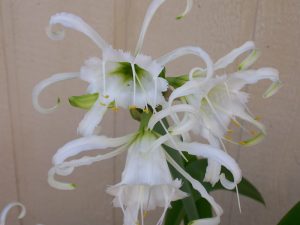Spider lily likes moist conditions – but not too much
Q. This flower was in my yard when I bought my house, and it was the most beautiful plant I have ever seen. It bloomed for the first two years that I was here, but for the last two it hasn’t. It has become so weak that the stems don’t stand up straight anymore and grow pretty much laying down. Do you know how I can save it? Is there any way to make the bulbs stronger or to save it? – KS
A. Looks like you have a lovely spider lily, known botanically as Hymenocallis occidentalis. It is native as far north as southwest Indiana, but may be semihardy in protected areas elsewhere in the state. Or yours could be one of the related species.
It is difficult to give specific management recommendations without knowing your state and county. The species is said to prefer moist, shady conditions, so it may suffer in hot, dry weather. On the other hand, excessively wet years may lead to bulb rot and weak stems.
Here are a few articles that provide further info on the species:
http://www.munchkinnursery.com/newsletter-past-year-titles-recent-titles-spider-lily
http://www.shieldsgardens.com/GLOVBulbs/HardyBulbs.html
See other related species at:
http://www.pacificbulbsociety.org/pbswiki/index.php/Hymenocallis
Q. During the mild December weather, some of our bulbs started to come up. What will happen to these plants when the weather turns colder this winter? Will they still flower this spring?
A. We’ve heard many similar reports from across the state about bulbs, perennials and some woodies coming out of dormancy. December 2015 was the third mildest on record in central Indiana, according to the National Weather Service. Some plants require less chilling units than others, resulting in some plants responding to mild conditions while others not. Many urban dwellers, in particular, may notice microclimate effects where protected locations seem more prone to this response.
In general, this is not the first or last time that plants have gone through similar or more extreme temperature fluctuations. While it is not likely to cause long-term damage, there could be decreased flowering potential if plants come further out of dormancy followed by normal or below-normal cold temperatures. There is much more weather to get through this winter before we can know the outcome!
